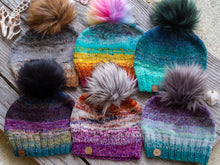Why are some seashells colorful? I’ve asked myself that for many years. A little digging through science journals tells me that the color comes from a seashell’s environment—so it’s either taken out of the water or from what they eat.
We know seashells’ colors come from their environment. But scientists don’t know yet how the colors get spread around, creating brilliant patterns.
You, too, can create your own mineral fade just like seashells by gathering the colors from your own environment! Use up leftover yarns to create a unique ombre fade hat.
Size
One Size – Average Adult
Approximate Finished Circumference: 19 ½” / 49.5 cm
Length: 9” / 23 cm
Materials:
(A 10% Buffer has been added to all yardages)
Fingering Weight Yarn:
A total of 250 yards / 229 meters in an assortment of colors
Purple / Orange Hat Sample
We used Cape May Fiber Sock (75% Superwash Merino, 25% Nylon, 463 yards / 100 Gram)
Color A: Potions (purple with hints of gold and magenta)
Color B: The Pink House (white with speckles of hot pink, grey and black)
Color C: Mermaid Mane (white and orange with speckles of hot pink, navy)
Color D: Siren’s Call (cool orange tonal)
Color E: Sockeye (deep orange with hints of gold and red, black speckles)
Needles
- RIBBING NEEDLE: Size US 6 (4mm) circular, 16” / 40 cm OR longer for magic loop method
- MAIN BODY NEEDLE: Size US 8 (5mm) circular, 16” / 40 cm OR longer for magic loop method and Size US 8 (5mm) double pointed needles (set of 5)
Tools
- 5 markers including 1 unique BOR (beginning of round) marker
- darning needle
Gauge
18 sts, 24 rows = 4” (10 cm) in stockinette stitch on MAIN BODY needle after blocking







